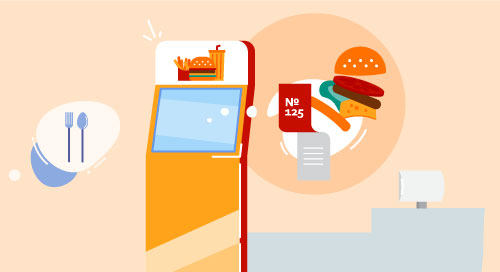Kiosks: Automatic for the People

Self-Self-serve kiosks have become a regular sight in fast QSR operations as restaurant groups awaken to their benefits – and the Coronavirus pandemic has only served to expedite their uptake.
“Kiosks were gaining momentum before the pandemic—lots of customers were saying they would prefer going to a restaurant that uses them versus one that doesn’t,” says Patrick Hagemeister, international account director at Pyramid Computer, which supplies kiosks to a number of high-profile restaurant groups.
“That trend has been enforced by the pandemic. People are definitely more willing to use them now.”
There have been concerns about the cleanliness of touchscreens during the pandemic and restaurant operators and technology providers have responded to these concerns. While some companies employ members of staff to wipe clean screens after each use, other simple solutions have included sanitisers being attached to kiosks, an approach implemented by Pyramid.
Furthermore, there is a drive towards creating touchless kiosks, where depth cameras can record customer movements enabling them to make a selection without having to touch the screen.
Touchless kiosks put QSRs back on track: Some see 60 percent higher revenue, says @Pyramidcompuk via @insightdottech
One such company that has recognised the advantages of installing kiosks is Hesburger, the largest fast food chain in Finland and the Baltics, operating in nine countries with around 500 restaurants. The company has begun equipping its restaurants with Pyramid’s Polytouch 32-inch Passport kiosks.
The kiosks contain an Intel® Core™ processor that ensures reliable and continuous performance with a payment module that handles every process quickly and efficiently. The screens display menu information in high resolution and the kiosks feature a wide-angle scanner that captures barcodes on promotional coupons. When not in use by a customer they display dynamic content and can be used as an advertising tool.
There are additional benefits to kiosks, which can increase customer order spend as well as help speed up wait times, says Hagemeister.
“It depends on how the menu is structured and if it allows for cross selling, but the more modifiers the menu has the better. If [a kiosk] is adding suggestions and keeps asking questions at every single step without bothering the customer so that they are still having a convenient customer journey, then the customer will order more.”
He suggests this is the case because kiosks can reduce the pressure on customers to make quick decisions and can also use high-quality food images to entice them to add to their order in a way that a vocal upsell by a cashier often can’t. The kiosks always provide a consistent experience unlike placing an order with a person, where the customer experience is entirely dependent on the staff taking the order
“When using a restaurant at rush hour, if you have a queue lined up behind you feel the pressure to not spend more time. If you go to the kiosk you will find nice pictures and it makes you hungry and the suggestions help. You have more time to carefully choose what you want and maybe order more.”
Hagemeister says some of Pyramid’s customers are reporting a 60% rise in average customer spend compared to the regular cashier. “That’s crazy high. The pandemic has made all restaurants suffer very much or most of them that haven’t been able to adapt to delivery and kerbside pick-up. When restaurants can reopen kiosks give them a good chance to earn more money and get back on track.”
Smile for the Camera
There are other advantages of using kiosks. Hagemeister points to software and hardware such as cameras fitted on kiosks that can see how many people are in a queue and which can reduce the number of menu items available accordingly in order to increase throughput. He also says that cameras could potentially be used for demographic recognition to help businesses make more intuitive upsells.
“Then you can recommend items based on gender and age, which will help create a list of items that you attribute to certain customer groups. Even first-time customers would get a recommendation based on age and gender.”
Intel also says that demographic recognition for kiosks can play an important role in the customer journey and that its technology can help transform kiosks from merely taking customer orders to being much more intuitive.
“An interactive kiosk in a restaurant does not only take your order and pass it back to the kitchen so that they can prepare it,” says Farhaan Mohideen, product strategy and IoT spokesperson at Intel.
Intel’s partners use both its hardware and software to build intelligent kiosk systems.
Mohideen suggests kiosks enabled with emotion recognition and gaze detection can provide key information to the restaurant. Facial expressions could provide information as to whether a customer might need help with their order or might alert the business to a problem with the software. Similarly gaze detection could recognise what caught the user’s eye and remind the customer at the point of checkout if they would like to add it to the basket.
“When I’m standing at a kiosk, if I’ve provided my credentials through an app or facial recognition it might show my past orders so I don’t need to go through the full menu to figure out what to order.”
As the kiosk develops its intelligence with AI algorithms, Intel provides software toolkits such as Intel® Distribution of OpenVINO™ toolkit that allows algorithms to be fully optimised to run AI inferencing best on its hardware.
This also opens new opportunities for partners to experiment and continue to innovate and bring new features to kiosks, says Mohideen, including enabling touchless interactions as well as integrating loyalty as part of a single transaction.